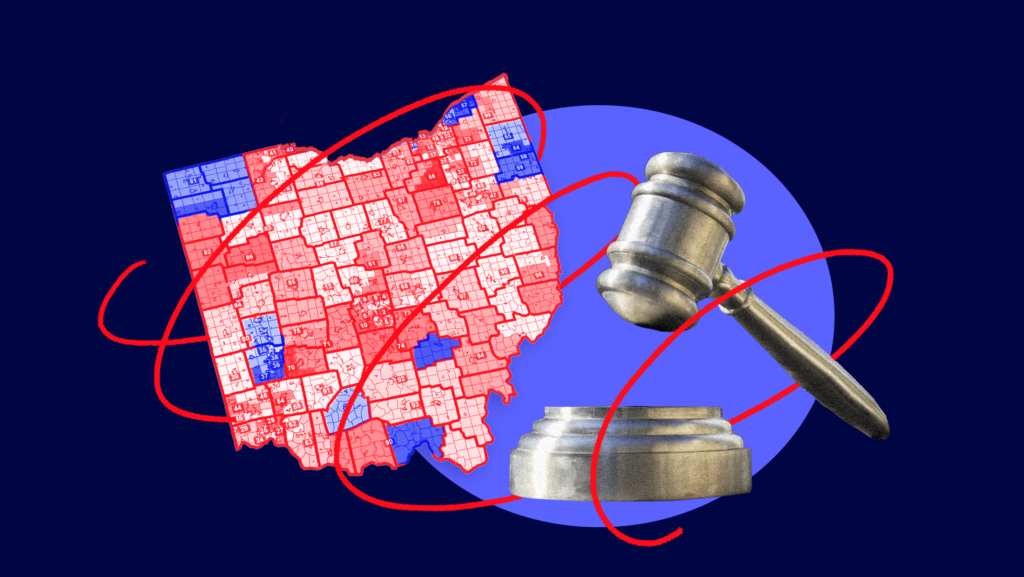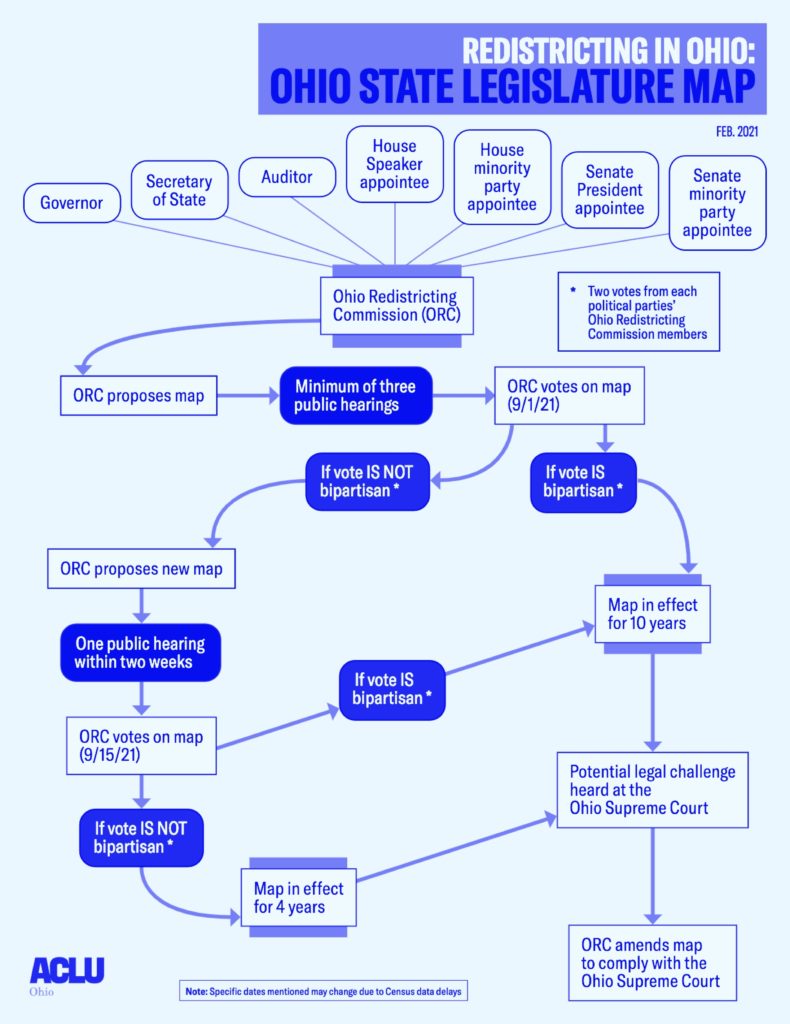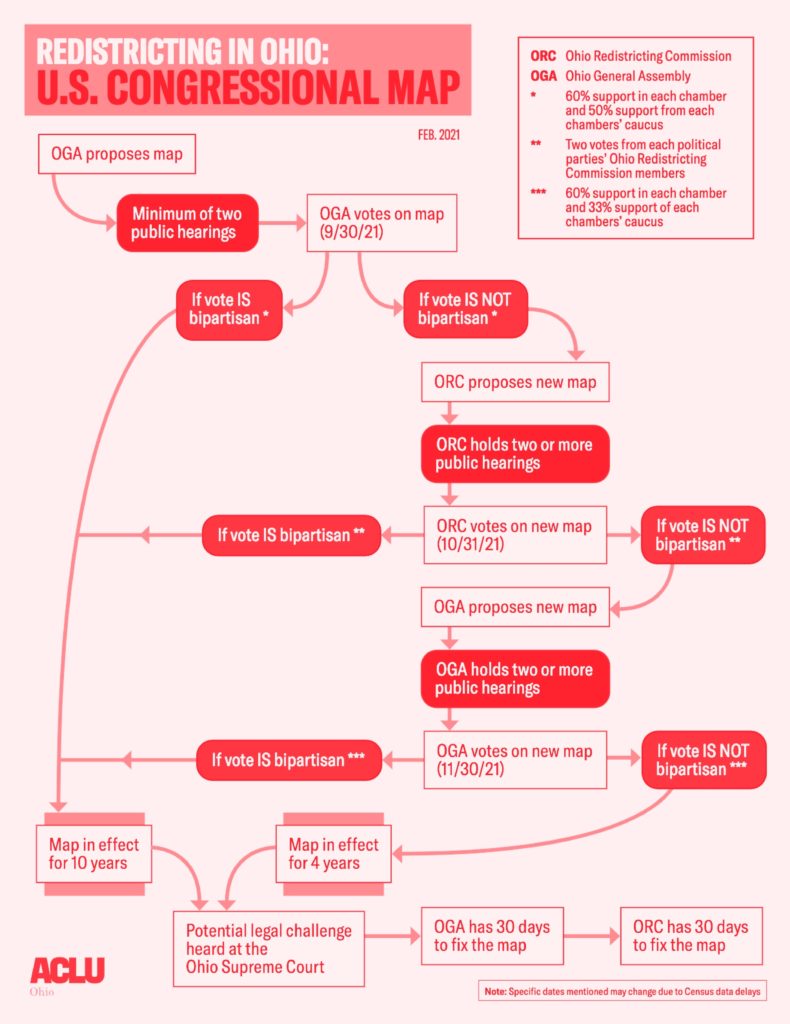Redistricting Rundown: Ohio

While redistricting is well underway throughout the country, this week we’re breaking down the latest developments in Ohio. In 2015 and 2018, Ohio voters approved a pair of amendments to reform the state’s redistricting process and limit partisan gerrymandering. Yet the Ohio GOP, rather than comply with the overwhelming majority of Ohioans, is attempting to entrench its legislative supermajorities. In today’s piece, we walk through Ohio’s reforms, how the Republican party has attempted to circumvent them and survey the court challenges that have already been filed to ensure Ohioans have fair districts.
Ohio voters approved amendments to curb partisan gerrymandering.
In 2015, Ohio voters overwhelmingly approved an amendment to the state constitution designed to completely overhaul the process for redrawing state legislative districts. The measure created an Ohio Redistricting Commission (ORC) of seven members — the governor, secretary of state, auditor and two members appointed by each party in the Legislature. To encourage bipartisanship, proposals have to be approved by at least two members of each party. If not, the maps will only be in place for four years before having to be redrawn again. Most importantly, the ORC is explicitly required to pass maps that do not favor one political party over the other in an effort to end partisan gerrymanders like the one Republicans enacted in 2011. Instead, the proportion of districts that favor each political party should roughly mirror the partisan breakdown of the state based on statewide election results. Any approved plan that does not meet the criteria laid out in the amendment, including the ban on partisan gerrymandering, is vulnerable to review by the Supreme Court of Ohio.
Similarly, in 2018 Ohio voters again approved changes to the redistricting process, this time for congressional redistricting. Under the second package of reforms, the Ohio General Assembly has the first opportunity to draw congressional districts. If the General Assembly fails to approve maps with the support of at least 60% of legislators and at least half of the minority party (currently the Democratic Party) in each chamber by Sept. 30, then the responsibility falls to the ORC. If the ORC fails to give bipartisan support to a plan by Oct. 31, the General Assembly has another opportunity to pass maps by Nov. 30. The General Assembly can either adopt a plan with 60% support and at least one-third of the minority party or a plan by simple majority. Any plan adopted by simple majority, however, is only in effect for four years and must not disfavor any political party. Like the state districts, congressional districts are also vulnerable to review by the state Supreme Court.
The ACLU of Ohio prepared helpful flowcharts summarizing the process below.


The Ohio GOP enacted a partisan gerrymander in violation of the redistricting amendments.
Despite the reforms approved by Ohio voters in the last decade, the state GOP is taking steps to maintain its partisan gerrymander of the state legislature. The Republican-dominated Ohio Redistricting Commission passed a legislative redistricting plan over the objections of the commission’s two Democrats minutes after the constitutional Sept. 15 deadline. Rather than enact a bipartisan plan with the Democrats, the Ohio GOP instead opted to pass maps that will only be in effect for four years and are projected to maintain Republican supermajorities in the General Assembly — with upwards of 63% of House seats and 70% of Senate seats favoring Republicans.
Since the vote was not bipartisan, the commission had to release an explanation of how the plan complies with the Ohio Constitution’s requirement that the plan not favor any political party. The Ohio GOP’s explanation is patently absurd. While it correctly notes the average vote share for Republican statewide candidates in Ohio is approximately 54%, it justifies awarding Republicans a proportion of legislative seats far in excess of this benchmark because Republicans have won 81% (13 of 16) of recent statewide elections. By this logic, it would also be permissible for a state like New York (where no Republican has won a statewide race since 2002) to draw maps where Democrats are favored in 100% of districts. Even Republicans on the commission, like Gov. Mike DeWine, expressed doubt that the maps would hold up to scrutiny by deviating away from the standards required by the state constitution. All of the Democratic proposals, which more closely matched the 54-46 partisan breakdown of the state, were ignored.
Meanwhile, the Sept. 30 deadline for the Ohio General Assembly to pass a congressional map has come and gone without even an attempt to secure a bipartisan compromise. As called for in the state constitution, the responsibility now falls to the Ohio Redistricting Commission, which will have until Oct. 31 to pass a plan with bipartisan support. If not, then the General Assembly will get a chance to draw maps again, including the option of passing a map with solely GOP votes. If the state’s legislative districts are any indication, it seems likely the GOP will also try to enact a gerrymandered congressional map in defiance of the state’s voters.
Ohio has already been sued over its state legislative maps this year.
Thanks to the cause of action created by the 2015 amendment to challenge redistricting plans in the Supreme Court of Ohio, several lawsuits have already been filed against the state’s new legislative districts. All three suits contend the maps violate the partisan gerrymandering ban the voters added to Article XI of the Ohio Constitution by unduly favoring the Republican Party. They ask the Supreme Court to order the commission to adopt a new plan that complies with the constitution and issue an injunction preventing any election to be held under the maps. The complaints also argue the commission failed to undertake a truly transparent process, incorporate the input of Ohio voters and meet constitutional deadlines.
League of Women Voters of Ohio v. Ohio Redistricting Commission
The first suit was filed on Sept. 23 on behalf of the League of Women Voters of Ohio, the A. Randolph Institute of Ohio and several individual voters. The complaint notes that although the U.S. Supreme Court has held that partisan gerrymandering claims are non-justiciable in federal courts, the high court “has also acknowledged that it is the providence of state courts to address the scourge of partisan gerrymandering.”
Bennett v. Ohio Redistricting Commission
A second suit was filed shortly after the first on Sept. 24 on behalf of multiple Ohio voters. The complaint draws particular attention to the redistricting plan’s treatment of minority voters. Rather than accurately reflect the will of communities of color, the plaintiffs argue that the plan “cracks and packs those communities, inhibiting their ability to organize to elect candidates of their choice, and diluting the strength of their votes.”
Ohio Organizing Collaborative v. Ohio Redistricting Commission
A third suit was filed against the commission on Sept. 27 on behalf of the Ohio Organizing Collaborative, Council on American-Islamic Relations of Ohio, Ohio Environmental Council and six Ohio voters. In addition to the claims raised by the other suits, the complaint argues the redistricting plan intentionally weakens the influence of the state’s growing Black and Muslim communities. It also alleges a violation of Article I, Sections 2, 3 and 11 of the Ohio Constitution — provisions guaranteeing equal protection, freedom of association and freedom of speech.
The Supreme Court of Ohio has scheduled oral arguments for all three suits on Dec. 8, 2021.
Ohio shows the limits of redistricting reforms.
Despite voters’ overwhelming support for Ohio’s redistricting reforms, the Republican Party is still trying to enact a gerrymandered legislative map. The GOP’s behavior underscores the limits of reform when one party will stop at nothing to preserve its political power. Ultimately, a functioning democracy requires both sides to accept each other’s legitimacy and right to win elections. While the Ohio Supreme Court still has a chance to step in and ensure Ohioans have fair maps for the next decade, the state’s Republican Party has already shown it has no interest in participating in fair elections.
Stay tuned for more information regarding Ohio’s redistricting process here.